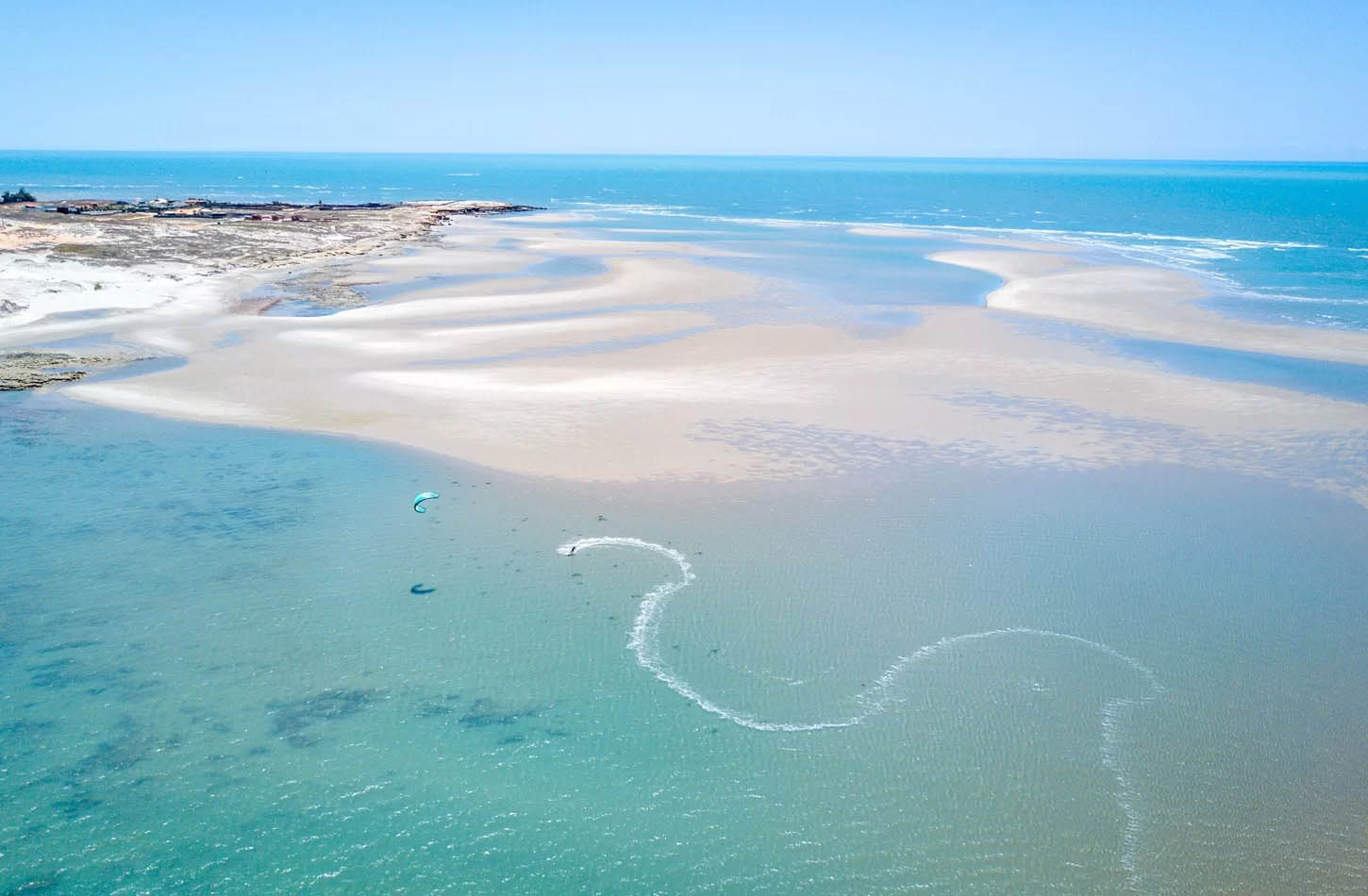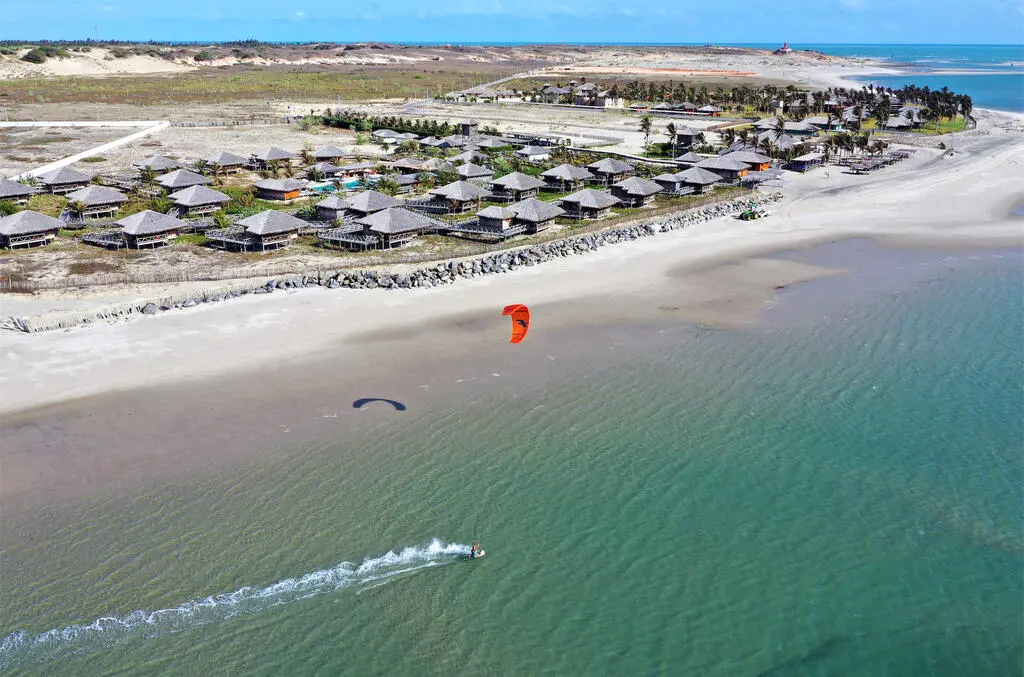
Pontal de Maceio (Fortim) - Plage
Brésil
🎓Déb · Inter · Conf
🌊choppy
💨19.8 nd
💧26.8°C
☀️27.2°C
Pontal de Maceio (Fortim)
Located on the sunny coast of Ceará, in northeast Brazil, Pontal de Maceió is a small, unspoiled fishing village bordered by an endless stretch of golden sand. Far from the hustle and bustle of the larger seaside resorts, it's a peaceful and authentic spot where the wind blows almost every day, creating a typically Brazilian atmosphere. The beach offers a superb natural setting, with its dunes, palm trees, and the mouth of the Maceió River, creating a contrast between the sea and the lagoon. The conditions are consistent, the water warm year-round, and the sailing area is immense, with no major obstacles. It's a perfect spot for riders seeking both performance and tranquility. Thanks to its constant east to southeast wind, Pontal attracts both Ceará locals and travelers looking for a quieter spot than Cumbuco or Icaraizinho. Here, time seems to slow down: we sail to the rhythm of the wind, we share caipirinhas at sunset, and we enjoy a Brazil that is still authentic.

Les données de vent affichées ici proviennent d’ERA5 (via Open-Meteo) sur 4 ans, retraitées pour refléter des conditions réalistes.
👉 Le vent moyen a été calibré pour éviter la sous-estimation habituelle des modèles.
👉 Les rafales ont été corrigées par un ratio médian afin d’éviter des valeurs extrêmes irréalistes.
👉 Chaque jour est résumé par le vent médian (P50) observé pendant les heures utiles (8h–20h), puis classé dans des plages de vent.
👉 Le mode pondéré mélange vent moyen et rafales pour refléter au mieux le vent ressenti.
- 🟢 10–16 nds : vent faible mais navigable (notamment en foil).
- 🟡 16–22 nds : plage idéale, conditions confortables pour la majorité.
- 🔴 22–28 nds : vent fort, réservé aux riders expérimentés.
- 🟣 28+ nds : conditions extrêmes, navigation engagée.
Localisation & Points d'intérêt
Informations utiles
Type d’eau
Profondeur
Navigabilité
Marée haute
Pas pied
Tech.
Marée basse
Partiel
Oui
Conditions de navigation
La Praia de Pontal est un spot océanique typique du Nordeste, large, propre et prévisible. Le vent side-onshore, d’est à sud-est, souffle entre 18 et 26 nœuds chaque jour pendant la saison. Le plan d’eau est choppy régulier, avec de petites vagues espacées à marée haute et un plan plus plat à marée basse. Le fond sablonneux, la plage infinie et la puissance maîtrisée du vent font de ce spot un terrain de jeu parfait pour le freeride. Les plus expérimentés adorent partir d’ici pour de longs downwinds vers Fortim ou Canoa Quebrada, longeant une côte sauvage ponctuée de falaises rouges et de plages désertes. Les débutants, eux, peuvent naviguer sans stress : la plage est immense, et le vent side-on ramène toujours vers la rive.
Vents dominants
East to southeast (E–SE) winds provide the best orientation, blowing side-on shore from the right. This direction ensures clean water, excellent upwind sailing, and stable conditions almost year-round.
État de la mer
The water is generally flat to slightly choppy near the shore, with small waves further out. The tides make the spot a little more technical with choppy waves and small waves.
Courants marins
Currents are weak to moderate and generally follow the direction of the prevailing wind. Near the mouth of the river, they become more pronounced and oriented towards the open sea, especially at low tide, requiring a little more vigilance.
Taille de kite recommandée
For a rider of around 70 kg, the recommended wings range from 9 m² to 12 m², with 11 m² often being ideal. The wind remains steady but rarely very strong, especially in the morning or at the beginning of the season, which justifies a slightly larger size.
Météo & vent
The wind blows regularly from the east to southeast (E–SE), with an average force of 18 to 25 knots, often more in the afternoon. It remains strong and constant from July to January, in a dry tropical climate around 28 to 32 °C, with very little rain in the windy season.
Climat
The climate is tropical and dry for most of the year, with temperatures remaining stable between 28 and 32°C. The dry season, from July to January, offers almost constant sunshine, while the rains are concentrated between March and May, often in the form of brief showers.
Profondeur
Entre 0,5 et 2 mètres selon la marée. Fond sablonneux sur toute la zone.
Température de l’eau
The water is warm all year round, fluctuating between 26 and 29°C. No need for a wetsuit: a simple lycra is enough to protect yourself from the sun.
Avis des kitesurfers
Chargement des avis...